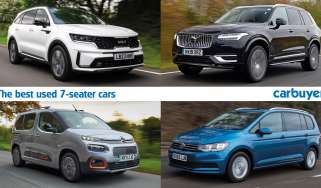Tesla Model X SUV - Range, charging & running costs
Zero emissions make the Tesla Model X very cheap to run
There's no getting around the fact that the Tesla Model X is expensive, whichever version you choose. With prices starting at well over £90,000 before a lull in production, it is considerably more expensive than most of its established luxury rivals. The cost becomes a factor that holds it back from scoring more highly.
While the Model X’s electric luxury-car status once made it a fairly unique product, it now has a growing number of rivals including the BMW iX, Audi Q8 e-tron and Mercedes EQS SUV. Although it's out of reach of many car buyers, the Model X’s negligible running costs will help balance out the high price for those who choose a Tesla. It's also worth noting that as of early 2023, the facelifted Model X is only available to pre-oder, with customers told exact prices will be finalised closer to its arrival date.
Tesla Model X range & charging time
With its long range and absence of any exhaust emissions, the Tesla Model X certainly has what it takes to save money on running costs compared to a conventional petrol or diesel SUV. However, its high purchase price places it out of reach of many motorists.
There’s one type of user for whom the high purchase price of the Model X might not matter – the small percentage of business drivers whose company-car allowance will stretch to the Tesla’s substantially high five-figure (P11D) starting price. If you belong to this rather exclusive club, it’s well worth considering the entry-level model against premium seven-seat diesel SUVs such as the similarly priced Mercedes GLS 350d or Range Rover TDV6 – if only for the huge savings you’ll make on company-car tax.
More reviews
In-depth reviews
A total absence of CO2 emissions means the Model X sits in the lowest band for Benefit-in-Kind (BiK) company-car tax. This means it’ll cost massively less to run than the aforementioned GLS 350d – the latter’s CO2 figure of over 200g/km places it in the top BiK bracket, attracting the highest company-car tax costs. Meanwhile, its BiK will be at the same level as the Mercedes EQS SUV.
Once the purchase cost of the Model X is out of the way, private owners can look forward to some serious savings compared to petrol or diesel SUVs of the same size – most notably a much-reduced fuel bill. Electricity is far cheaper than petrol or diesel and all models have an impressive range. This means you’re not limited to short urban trips within dashing distance of a recharging point.
The standard and Plaid models in the Model X range have the same battery size, but varying power outputs and maximum ranges. The 100kWh battery pack of the standard Model X has a 348-mile range but the Plaid model manages 333 miles. These range figures are no longer class-leading, with the BMW iX xDrive 50 capable of up to 391 miles on a single charge.
It should be remembered, though, that the car’s actual range will vary between drivers. Tesla admits that range will vary depending on cruising speed, outside temperature and whether your air-conditioning is switched on or off. However, with increasing numbers of fast-charge points appearing at motorway service areas, a mid-journey charge can be scheduled during a lunch stop, making long-haul family road trips a possibility – something not all electric cars can offer. The ever-growing Tesla Supercharger fast-charge network can top up the Model X to 80% within half an hour.
The Model X is exempt from VED (road tax) until 2025, when all EVs will be charged at the standard rate following a first-year discount.
Insurance
Perhaps due to high repair costs and the Model X’s brisk performance, all versions occupy insurance group 50, the highest banding there is. This compares to the group 45 rating of diesel Range Rovers, although the Mercedes GLS 350d is also placed in group 50. It’s certainly worth obtaining an insurance quote before you decide to buy.
Warranty
Tesla offers an impressive warranty for all cars supplied in the UK, although it’s supplied by AXA insurance rather than Tesla itself. It’s a four-year/50,000-mile policy, while the battery and drive units are covered separately with an eight-year/unlimited-mileage warranty. The main warranty can be extended for up to a total of eight years.
Servicing
Tesla states that its cars require less mechanical servicing than conventional petrol or diesel models, but recommends an inspection every 12,500 miles – or yearly, whichever is the more frequent. Maintenance plans are available to help spread the cost of servicing. Software updates can be performed during scheduled maintenance appointments, or downloaded ‘over the air’ by the car’s on-board Internet connection. Tesla suggests that you connect your vehicle to your home’s Wi-Fi network for the fastest possible download time.











